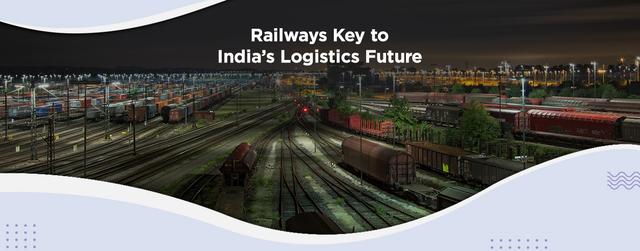
Cogoport: A Global Trade Platform
Cogoport leverages technology and caters to enterprises of all sizes. Our solutions improve predictability and enhance human capabilities.
India’s logistics policies have focused more on road transport, a mode which ended up cornering 70 per cent of freight transport in the country. Insufficient rail capacity, particularly on some high-density routes has been found to be one of the causes for the decline in rail freight volumes.

For a country with low coast-to-landmass ratio, India needs a massive freight transport transition from roadways to railways. Projected to grow five-fold by 2050,India’s logistics realm must usher in international competitiveness and standards to achieve savings worth Rs 10 trillion (Rs 10 lakh crore), a goal set for 2022. Let’s dive deep to know more on the opportunities presented by railways.
India’s logistics sector amounts to 5 per cent of the GDP, employs nearly 22 million people (2.2 crore), and handles around 4.6 billion tons of goods a year. Currently, Indian roadways handle 70 per cent freight when compared to 18 per cent by railways.
Among the goods originating from a variety of domestic industries, 39 per cent have been identified as mining products, 22 per cent as agricultural products, and the balance 39 per cent are manufacturing related commodities.

Between 2015 and 2020, India logged an impressive GDP growth rate, which went on to shoot freight demand by 28 per cent. Similarly, rising income levels, skyrocketing e – commerce sector, higher exports, and a growing retail sales market are also slated to give a boost to freight.
Most of these goods are handled by trucks and other vehicles while the railways, coastal and inland waterways, pipelines, and airways account for the remaining.
The Golden Quadrilateral road network coupled with two more diagonal highway networks linking Mumbai, Chennai, Delhi, and Kolkata host 50 per cent of India’s total freight movement, half of which passes through the roadways and the balance by rail and a tiny component on water.

India once had a high share of rail freight but that gradually lost out to roadways starting 1951 due to the challenges of imbalanced capacity distribution, over utilization, track sharing, lower speeds, and lack of arrangements to aggregate smaller loads.
Imbalanced capacity distribution challenge highlights the issue of seven main routes contributing 60 per cent of freight traffic but constituting only 16 per cent of railways route network, resulting in overuse and not programmed to handle high traffic density.
Similarly, two-thirds of India’s railway lines are already over 100 per cent utilization, exceeding 80 per cent usage regarded as ideal.
Track sharing challenge involves the use of the same set of tracks for both passenger trains and freight trains with the former being more prioritized, ending up raising the lead times for rail freight and its reliability.
Further, freight trains in India carry smaller loads and ply at lower speeds than global standards, resulting in stretched out lead times and reducing the capacity of the network.
Moreover, lack of arrangement to aggregate smaller loads requires a shipper to contract a full train to move freight, including not having a standardized process to aggregate smaller loads for booking individual or partial wagons.
As a result, non-bulk commodities like consumer goods, electronics, automobiles, and others are transported through trucks.

Some of the possible solutions to increase the share of railways in freight movement are as follows:
Dedicated freight corridors offer the luxury of only shipping goods on tracks by eliminating passenger trains. The Indian government has made investments in building such corridors with the eastern and western corridors planned to commence in 2022 and four others to be undertaken soon.